
Practice Perfect 794
ABFAS LEADing the Way to Life-Long Learning for Podiatrists
ABFAS LEADing the Way to Life-Long Learning for Podiatrists
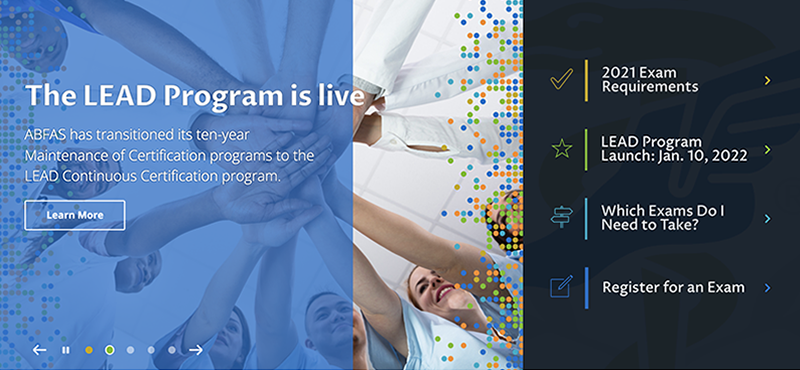
For those of you who are board certified by the American Board of Foot and Ankle Surgery (ABFAS), this one is for you! As you are probably aware, the ABFAS recently instituted its LEAD Program for those who are board certified. Starting January 10, 2022, instead of taking an exam every 10 years to recertify, you will instead participate in a structured ongoing certification process. This essentially consists of answering online quiz questions quarterly demonstrating academic knowledge. The ABFAS has some good explanatory materials on their website, but as a podiatric public service announcement, I’m using myself as a guinea pig to hopefully save you some time and anxiety.
The ABFAS has pivoted away from the one-time-in-10-years-and-forget-it type of recertification examination and has responsibly moved toward ongoing education to help us all become better foot and ankle surgeons.
This process is somewhat comparative with the American Board of Podiatric Medicine’s (ABPM) Maintenance of Certification (MOC) program. Both boards now have ongoing methods for us to demonstrate our knowledge, although the methods of each are a bit different.
Let’s first go through the main points in a high-yield fashion. Then, I’ll quickly review my experience and perceptions after going through the first set of questions. The information provided below is directly from the ABFAS website and their educational materials. Interested parties should review the rules to understand the process and what it will mean for you.
Important Details About the LEAD Program
- What is LEAD? This is an ongoing process of recertification meant for those who are certified with the ABFAS in either Foot Surgery, Rearfoot Reconstruction and Ankle Surgery (RRA) or both.
- Why did ABFAS do this? They want to provide “bite-sized” learning assessments in an ongoing manner rather than one exam every 10 years. They aim to improve the experience with the board, providing assessment relevant to clinical practice, using adult learning theory to provide life-long learning with feedback.
- All certified diplomates are automatically enrolled in the program regardless of your status as either “Time-Limited” (all of us certified after 1990) or “Lifetime Certified”.
- There is no additional fee for the program, but our ABFAS dues have been increased by $90.
- Participation is required.
- This process will not change your certification expiration date.
- Each quarter a candidate takes 30 timed questions (you’re given three minutes per question). Test takers receive immediate feedback, being told if the answer is correct/incorrect, and then given resources to learn more if knowledge gaps are found. For those certified in Foot Surgery only, there are 30 foot-related questions. For those Foot/RRA certified, 20 questions are Foot-related and 10 are RRA-related.
- Diplomates are required to take one 30 question test/quarter, with 12 quarters over a 5-year period, with two 5-year periods over a diplomate’s 10 years of certification. These must be completed by June 30 of the year of your certification’s expiration. For perspective, there are 4 quarters/year x 5 years = 20 quarters, and we must answer questions covering 12 of those 20 quarters. This would have to be done twice over a 10-year period to maintain certification. That’s a total of 360 questions/5-year period or 720 questions/10-year recertification period. This would be a lot of questions if done as one exam but is less intimidating given the longer time periods under consideration.
- The questions can be answered any time during the quarter and do not have to be done at one time. The test is open book, and diplomates can study from whatever sources they see fit.
- The test is NOT pass/fail. Instead, it uses Measurement Decision Theory (MDT) which analyzes the probability that a diplomate is staying current with their knowledge (called MDT p-value). The initial baseline is an MDT p-value of 95% (0.95), but don’t panic. The minimum score we need to “pass” is 0.1 or 10%. The ABFAS did a pilot study of 500 people, and they found the mean MDT p-value was 0.8. Only those who are certified after 1990 have to meet the minimum MDT p-value.
- You will have the opportunity to improve your score over time as you study, focusing on your areas of deficiency. The MDT p-value for each person is continually updated, so improving scores on subsequent tests will improve the MDT p-value.
- Other requirements to maintain certification beside participating in LEAD and maintaining above 0.1 MDT p-value are: an unrestricted license, continuing privileges at a hospital or surgery center, 100 CMEs every 5 years, and attesting to performing surgery within the last 2 years.
- There are slightly different requirements based on what year you recertify, with the requirements being a little more stringent for those recertifying in the next few years. Here’s an example using my personal statistics (check the website for your requirements). I’m up for recertification in 2023. The information below comes directly from the ABFAS website. Over the next 1 ½ years (6 available quarters), I will have to take tests covering 4 of those quarters. Someone recertifying 10 years from now will not have to worry about taking as many tests in the next couple of years. As you’ll see below, this really is not a big deal.
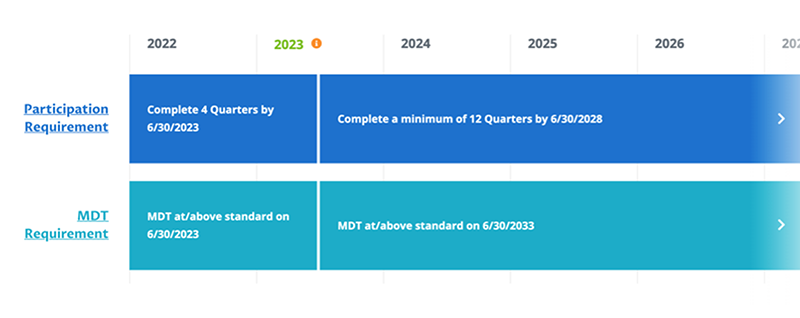
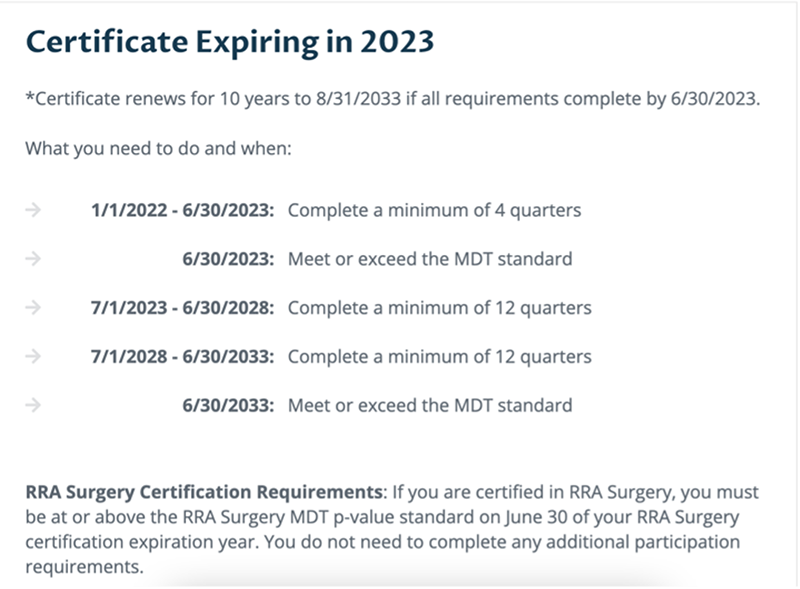
One Diplomate’s Experience and Perceptions
Over about 60 minutes, I examined the ABFAS LEAD program website and reviewed its resources. I found the site generally easy to use and their resources to understand the program sufficient. They have a good explanatory video, a PDF document, and some tutorials on using the system that are all well-done and professional.
Currently, one set of 30 questions is available for this first quarter (see the figure immediately below), and although you can take the test in more than one sitting, I decided to take it all at one time and without preparation.
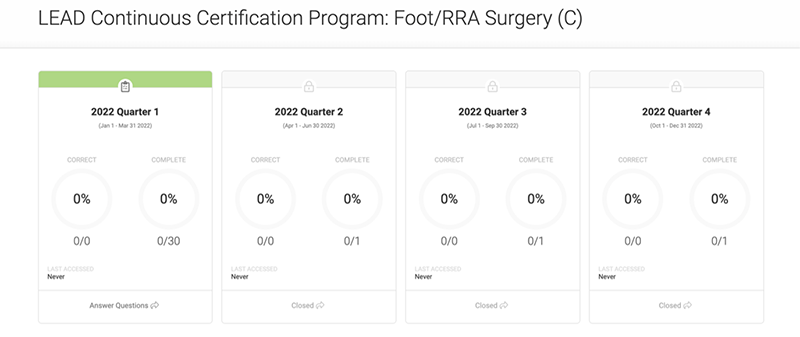
I found the questions to be highly pertinent to the practice of modern foot and ankle surgery, and they were not excessively difficult. The questions were straight forward and clear, and the accompanying images were easy to see. I would guess I answered the questions in an average of 20-30 seconds, so that 3-minute time limit seems more than sufficient. Reporting my score and the MDT p-value were clear and easy to access.
Once a question was answered, a short rationale statement was shown with a reference for further reading. This is in line with their stated goal of providing feedback. The rationale statements for why a correct answer was correct could use a little work with more detail and discussion.
There were nine questions that caused me to seek out the supporting references (whether I got them correct or incorrect), which is what they want us to do to learn more and maintain lifelong learning. The references were listed with hypertext links to outside sources, but, through no fault of the ABFAS, I can see this being a problem for most practicing podiatrists. Of the nine citations I explored, only one was downloadable for free. One of the nine was from a textbook chapter, six were accessible through my University employer’s Pub Med access, and two required special order through the University. I’m not sure how a foot and ankle surgeon without access to online publications would be able to read these sources. However, I can’t blame ABFAS for this. It’s not their responsibility to help us find publications. That’s an entirely different problem.
Overall, I found the process easy and not intimidating. Thirty questions did not take long, were not difficult, and they did spark my curiosity to learn more (including questions where I got the answer correct). The LEAD program itself is not onerous and seems fair from my standpoint. It appears well thought out, organized, and with clear instructional materials. The ABFAS has pivoted away from the one-time-in-10-years-and-forget-it type of recertification examination and has responsibly moved toward ongoing education to help us all become better foot and ankle surgeons. I applaud the ABFAS for their hard work and leadership and am looking forward to continuing with this process.
Best wishes.

Jarrod Shapiro, DPM
PRESENT Practice Perfect Editor
[email protected]




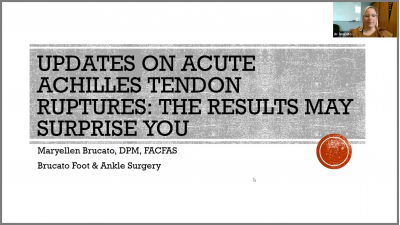




























Comments
There are 0 comments for this article